
If you’re looking to achieve a change in body composition (less fat, more muscle or both), a DEXA scan is an excellent way to measure your progress.
The question, then, is how frequently should those progress checks be?
Upfront, we can confidently say (after 10 years and 22,000+ scans) that the best scanning frequency for most people is once every three months, and no less frequently than every six.
Here’s why.
“DEXA scans taken every three months or so would confirm whether my hard work was paying off.”
Most customers turn up to their first DEXA scan at Bodyscan declaring that they need to lose fat.
Of course, if everything else (muscle, body water, etc) stays the same and you lose body fat, your weight will also fall. In other words, a drop in fat will mean a drop in weight.
But it’s a one-way relationship. Meaning a reduction in weight on your bathroom scale does not necessarily mean you have lost any fat.
For most people, fat loss occurs at a ratio of around three units of fat to one unit of lean mass (essentially muscle). In other words, if you lose 4kg on the scale, we might typically expect that to be made up of 3kg of fat and 1kg of lean mass (3-to-1).
But the DEXA result below shows a Bodyscan customer, Martin, whose 4kg of weight loss, achieved over 14 months, turned out to be ALL muscle. That’s a ratio of 4-to-zero. Not a result anyone would hope for.
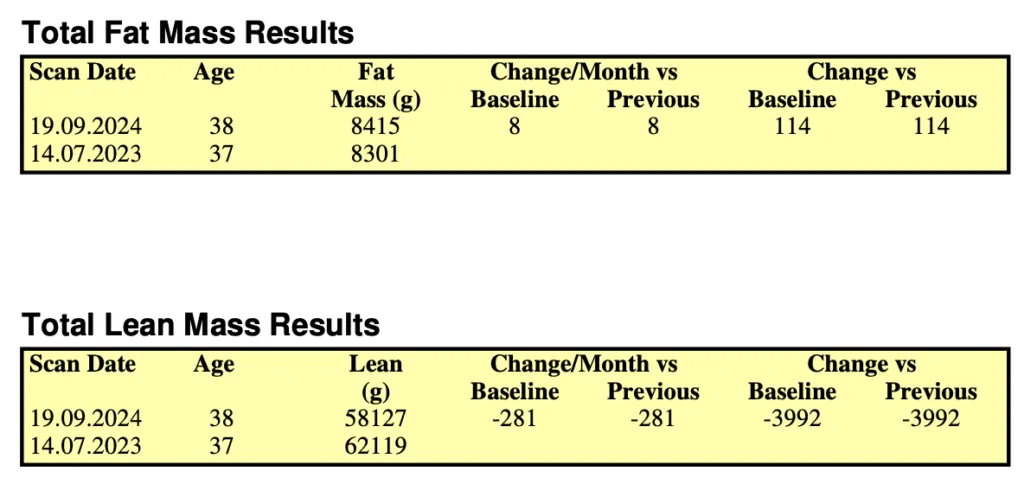
Martin’s 4kg weight loss was all lean body mass, with a tiny increase in fat (114g). There could have been periods of fat loss followed by fat gain, but with the two snapshots 14 months apart and no datapoints in between, we can’t be sure.
We must emphasise that, over the longer term, Martin has achieved a remarkable and inspiring body transformation, but between these two scans, taken over a year apart, Martin’s results went backwards.
He says, “It was a hard truth to see that I’ve worked my butt off for the last 14 months and yet regressed in my long-term goals. But the result makes sense because I knew I had not consistently stuck to the regime of diet and exercise that I know works.”
Martin continues, “It’s not convenient for me to travel from Bristol to Bodyscan regularly but, in an ideal world, scans taken every three months or so would confirm whether my hard work was paying off.”
Martin’s point (and ours) is that if things are not going as you’d planned then it’s better to know in good time before you continue too far down the wrong path. It might be a slight course correction or a 180-degree turn, but DEXA scans taken closer together will help you plot a quicker and more efficient path between A and B.
Whether it’s every three, four or six months, check-ins that show a trend give you a more granular and informative picture of what’s going on, as you can see from the compartmental charts below (fat in yellow, lean mass in blue).
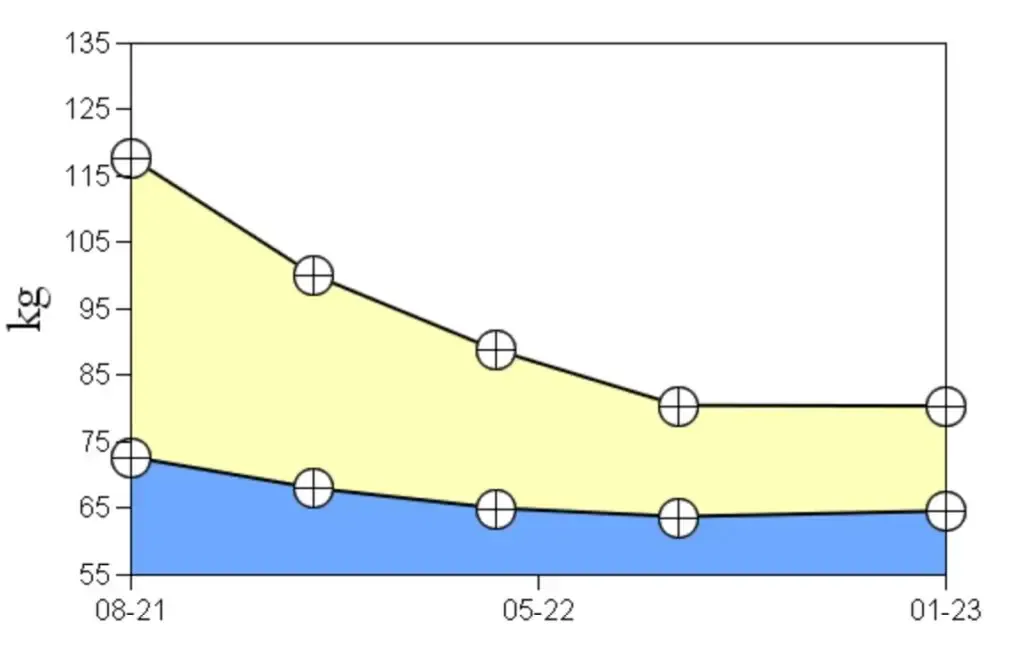
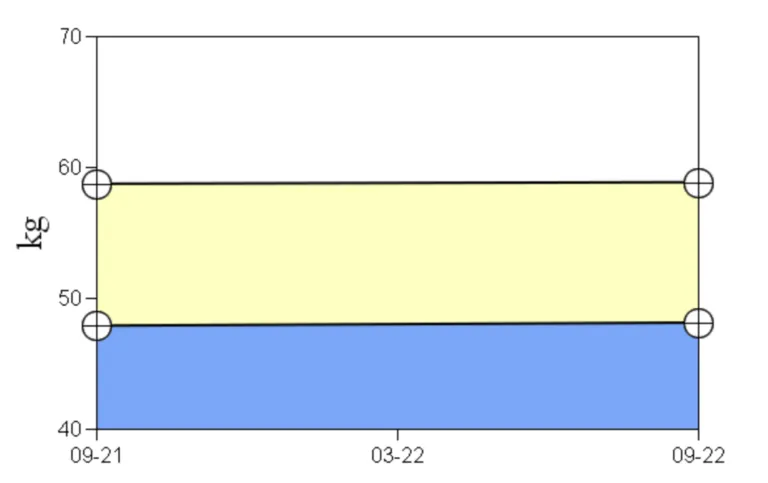
Scans taken frequently (left) show what is happening with more granularity. Every scan gives you an opportunity to make a decision about your programme.
Every DEXA scan (or any measurement) is a snapshot of a point in time. In the charts above, the subject on the right might insist that she has lost fat but the reference point in her mind for the start of that fat loss (likely the last few months) is not the same reference point as measured by the previous scan, exactly a year earlier. She may well have lost weight in the previous three months, but the scans show (and the weight on her bathroom scale would have shown) that she must therefore also have gained the same amount of weight in the nine months before that.
“If I’d had my DEXA scan sooner, I would have seen I was headed in the wrong direction and made changes.”
Earlier, we said that most people come to Bodyscan with the primary goal to lose fat. While for others, the priority is to gain muscle.
Bodyscan customer, Luke, is one such client and, you might say, the perfect mirror to Martin.
Luke had his second scan 13 months after the first, to measure the progress of a slow and steady bulk, fuelled by 2g of protein per kilo of body weight and a consistent weights programme.
But Luke’s 4kg of carefully nurtured weight gain turned out to be ALL fat and no muscle. Again, not a result one would hope for.
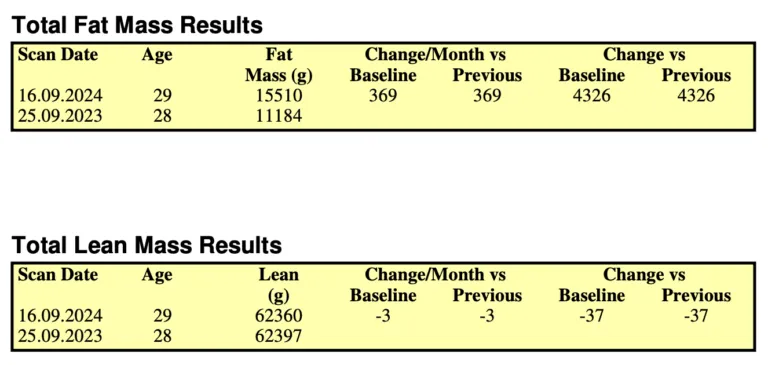
Luke’s weight gain was all fat: 4.3kg and no change (-37g) in lean mass
Luke was baffled (not to mention dispirited) by the result. “I was fairly confident I was gaining muscle because my weight was increasing very slowly and my strength was going up in line with that.”
Indeed, his slow pace of weight gain (just under half a percent of bodyweight per month) would, on paper, suggest close to 100% muscle-gain during a long, resistance-led calorie surplus.
“My weight training sessions were frequent, well-focused and (I thought) effective. I was consuming about 190g of protein a day and I was making good strength gains,” he says.
“I’m pleased I got stronger but, as mass-gain was my goal, my training turned out to be, at best, sub-optimal. At worst you could say I’ve wasted a year of hard work.”
“If I’d had my follow-up DEXA scan much sooner, rather than wait a year, I would have seen that I was headed in the wrong direction and could have made changes.”
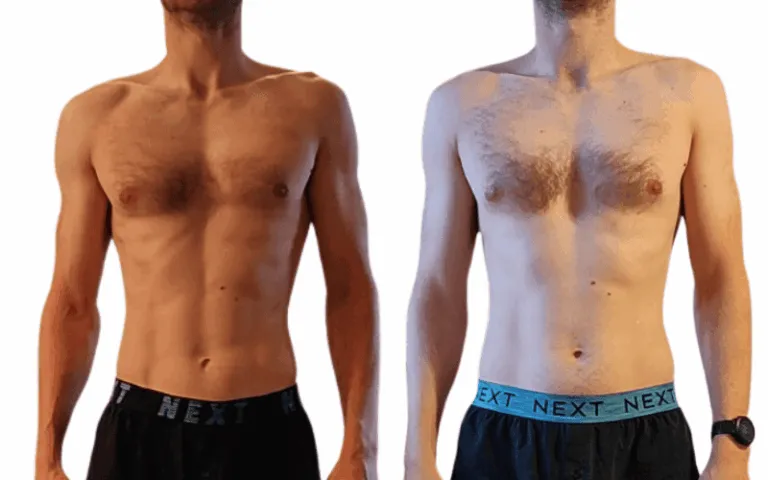
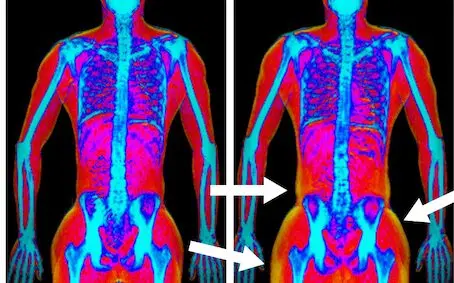
It’s easy to see why it wasn’t obvious to Luke he was gaining fat. At over 190cm (6’3″), the 4kg extra fat mass is ‘thinly’ distributed across a tall physique. The DEXA images suggests most of it is in the gynoid region (hips and butt, the areas not seen when standing in underwear), as well as a little around the belly area.
Luke is no newbie; he has been weight training for eight years and, after 10 months of getting leaner, dropping from 90kg to 78kg, he had his first DEXA scan in September 2023 to “inform the next steps.”
But any measurement, however precise or accurate, is only a snapshot of that point in time. The more data points you have, the more granular the picture and more clearly you can see what’s going on. The consistency of DEXA means you can trust the results of that trend.
Rob Webster, Bodyscan’s body recomposition specialist and, coincidentally, Luke’s consultant, says: “There are well-proven ‘classic’ bodybuilding basics for achieving hypertrophy (gains in muscle mass), such as maintaining a consistent calorie surplus, sufficient protein and a resistance programme optimised for volume, intensity and rest periods.
“But our genetics are unique, we each respond differently to a given stimulus. On paper, Luke’s nutrition and exercise (his input) look fine, but the output is a long way from what another individual may have achieved,” says Rob.
“You need to establish your train-and-test frequency with reliable and precise DEXA scans, not scale weight or strength.”
“We can get all scientific and talk about muscle protein synthesis and for how long it peaks after a workout but it’s impossible to measure without becoming a lab rat. It’s much simpler than that.
“Everyone needs to establish what frequency and volume their body best responds to by measuring the output of a train-and-test protocol. And that output measurement needs to be reliable and precise (DEXA), not photos, scale weight or strength,” Rob says.
“In the early stages, a more frequent cadence of DEXA measurements will reveal if the programme is working so you can modify the programme accordingly. You need to establish a trend so you can calibrate not only your diet and exercise but also the best frequency for you to check in and measure progress.”
It’s clear that Luke is a genuine ‘hard gainer’ which, based on his looks-good-on-paper programme, probably means that his training frequency and volume is not enough to create the desired response.
As for strength gains being mistaken for muscle gain, this is a common red-herring. Rob says, “Strength adaptations can occur independently of hypertrophy, they are not perfectly aligned. Strength gains can come from adaptations in the nervous system rather than from just having bigger muscles.”
Luke is in agreement: “If I didn’t have to travel into London, I’d have used DEXA scans throughout the year to better track my progress. There are so many variables that can affect muscle gain – what works for one person may not work for another – that without frequent DEXA scans, it’s impossible to know what composition changes are going on.”
DEXA scans taken a long way apart typically mean that your mental reference point is not the same as the measured reference point, so the result will usually disappoint.
As well as enabling you to course-correct in good time, there are other good reasons to have your DEXA scans at regular intervals.
Accountability
Every DEXA scan keeps you accountable. An ‘exam’ date on the horizon means you have a shorter-term goal, rather than something way off, out of sight, in the distance. Goals far in the future always end up at the bottom of your to-do list (think: young people saving for their retirement!)
Common Reference Points
As mentioned above, it makes sense that the reference point in your head (or your app, notebook or photos folder) for when you started to lose fat or gain muscle is the same as the reference point for an accurate DEXA measurement. Meaning: if you have two scans a year apart, the second DEXA result will be comparing your body composition with a snapshot taken 12 months earlier. In reality, you might have let things drift and put on some weight for, say, six months after your first scan before you knuckled down, were consistent with diet and exercise and started to track things by taking photos, scale weight, etc. In the second half of the year, when you ‘got serious’, you lose the weight you put on in the first half.
Therfore, the results shown by the follow-up DEXA scan (a year later, no change in weight or body composition) do not match the results in your app or photo library, simply because they are measuring different periods of time. Your reference point is not our reference point (and you’ll be confused as to why the scan didn’t match your expectations).
Realistic time frame
Three months between scans is long enough for something meaningful to have happened, particularly if your goal is fat loss. After three months, it is not a tall order for you to lose 3kg of body fat (and for many fat-loss clients, we would suggest not returning until your weight has dropped by this amount – see body water below).
Twelve weeks is also long enough to suggest that you are going to stick with the programme and your efforts are not a flash in the pan.
Regulations permit scans every eight weeks but we believe the optimum period is 12 weeks for both of the reasons above.
Body water
Your body water (affected by hydration, salt intake and your menstrual cycle, among other things) can easily affect your weight by 2kg or more and is measured as lean mass on your DEXA report.
Therefore, a 2kg change in lean mass between scans a year apart does NOT necessarily mean you have lost or gained 2kg of muscle mass. It could easily be a variation in body fluid from one scan date to the next.
It’s therefore critical for those intending to build muscle mass that you establish a trend (as Bodyscan customer Nathan did here) of consistent, positive increases in the lean mass result. Only then can we be sure that skeletal muscle mass is increasing and variations in water weight have been accounted for.
Motivation
Punching the air after a good result is as important as course correction after a dispiriting one. A DEXA scan that shows good progress is a great motivator to keep going with what might be a very long-term and daunting objective, such as losing 30kg of fat. (As for muscle gain, at typically 50-300g a month, this should be treated as long-term for everyone.)
We look forward to seeing you at Bodyscan soon!
Philip Chant
Director
Special thanks to Martin and Luke for kindly sharing their results